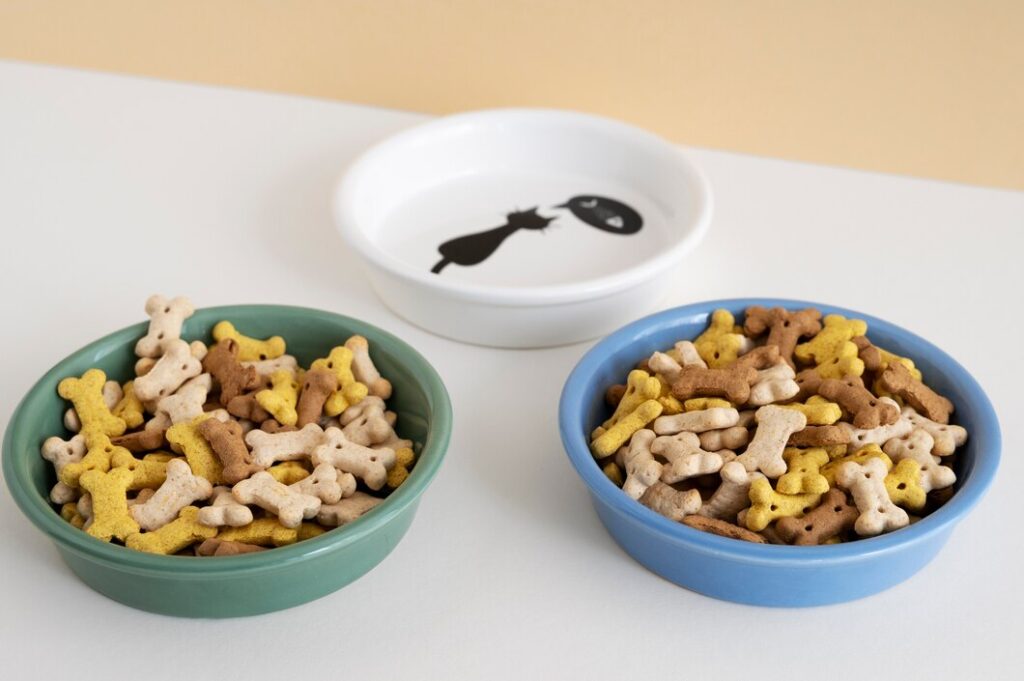Dog treats are a fantastic way to show our furry companions love, reward good behavior, and keep them occupied during training sessions. However, with shelves overflowing with colorful packages and enticing claims, navigating the world of dog treats can be overwhelming.
This blog post explores the dos and don’ts of vet-approved dog treats, helping you make informed choices that keep your pup happy and healthy.
The Dos of Dog Treats
- Prioritize Quality Ingredients: Look for treats made with whole, natural ingredients like lean protein sources (chicken, fish), healthy fats (flaxseed, salmon oil), and fiber-rich carbohydrates (sweet potato, brown rice). These ingredients provide essential nutrients for your dog’s health and well-being.
- Consider Your Dog’s Needs: Choose treats that cater to your dog’s specific needs. For example, if your dog is a senior, opt for softer treats that are easier to chew. For weight management, focus on low-calorie options made with ingredients like pumpkin or dehydrated vegetables. Does your dog have allergies? Look for treats formulated with limited ingredient lists to avoid potential allergens.
- Portion Control is Key: Treats should be offered in moderation, typically no more than 10% of your dog’s daily calorie intake. This helps maintain a healthy weight and prevents overfeeding. Here’s a helpful trick: Deduct the treat calories from your dog’s daily food allotment to ensure they stay within their calorie budget.
- Embrace Training Opportunities: Use treats as positive reinforcement during training sessions. Small, bite-sized treats are ideal for rewarding good behavior immediately after your dog performs the desired action. This positive reinforcement technique helps your dog learn commands and desired behaviors quickly and effectively.
- Promote Dental Health: Some dental treats are formulated to help clean your dog’s teeth and freshen their breath. These treats often have a rough texture that helps scrape away plaque and tartar buildup. Consult your veterinarian to choose the right dental treat option for your dog, considering their age, dental health, and chewing habits.
- Get Creative with Homemade Treats: Whip up healthy, homemade treats using vet-approved ingredients. This allows you to control portion sizes, customize flavors for your pup’s preferences, and avoid any unnecessary additives or preservatives found in commercially prepared treats. Check out our companion blog post “Vet-Approved Low-Calorie Dog Treat Recipes” for some pawsome ideas!
The Don’ts of Dog Treats

- Avoid Artificial Ingredients: Steer clear of treats containing artificial colors, flavors, and preservatives. These additives can irritate your dog’s digestive system and offer no nutritional value. They can also trigger allergic reactions in some dogs.
- Beware of Excess Sugar and Fat: Treats high in sugar and fat can contribute to weight gain, pancreatitis, and other health problems. Limit sugary treats like yogurt drops and fatty options like fried treats. Look for treats with low sugar content and healthy fat sources like omega-3 fatty acids found in fish oil.
- Skip the Human Food Scraps: Our food isn’t always suitable for dogs. Foods like grapes, raisins, chocolate, onions, and avocados can be toxic to canines. Always check with your veterinarian before sharing human food with your dog. Certain foods, even in small quantities, can cause serious health problems in dogs.
- Don’t Use Treats as a Substitute for Meals: Treats are meant to supplement your dog’s regular diet, not replace it. Ensure your dog receives a balanced and complete meal formulated for their age, breed, and activity level. A nutritious diet provides essential vitamins, minerals, and other nutrients your dog needs to stay healthy and thrive.
- Overlook the Calorie Count: Don’t be fooled by packaging claims. Always check the calorie content of treats and adjust portion sizes accordingly. Treat packages may boast about the delicious flavors or cute shapes, but the most important information for you is the calorie content per serving.
- Forget to Supervise New Treats: When introducing a new treat, monitor your dog for any allergic reactions or digestive upset. Some dogs may have allergies to certain ingredients, and introducing a new treat could trigger an allergic reaction. Signs of an allergic reaction in dogs can include itching, vomiting, diarrhea, or swelling.
Choosing the Right Treats: A Few Extra Tips
Here are some additional factors to consider when selecting the perfect treats for your canine companion:
- The Right Size Matters: Choose treats appropriate for your dog’s size and chewing ability. Smaller treats are ideal for training sessions and toy breeds, while larger chews can keep bigger dogs occupied and mentally stimulated. Offering treats that are too large can be a choking hazard, especially for smaller dogs.
- Consider Texture: Variety is key! Opt for treats with different textures to keep things interesting for your dog. Some dogs enjoy softer treats that are easy to chew, while others prefer something more challenging like bully sticks or dehydrated chews. A mix of textures can help satisfy different chewing preferences and provide dental benefits.
- Read the Label Carefully: Don’t underestimate the power of the label. Look for treats made in the USA with human-grade ingredients. The label should clearly list all ingredients, including the primary protein source. Avoid treats with vague ingredient lists or those containing unknown fillers.
- Freshness Matters: Just like humans, dogs prefer fresh food. Choose treats with a long shelf life and store them in an airtight container in a cool, dry place. Discard any expired treats to avoid your dog ingesting spoiled food.
- Consult Your Veterinarian: If you have any concerns about your dog’s dietary needs or allergies, your veterinarian is your best resource. They can help you choose the right treats based on your dog’s health and recommend options that address your dog’s specific needs.
Conclusion
By following these dos and don’ts, you can make informed choices when selecting treats for your beloved dog. Remember, treats are a fun way to show your dog love, reward good behavior, and promote dental health. However, moderation and prioritizing healthy ingredients are key to ensuring your furry friend enjoys a long and healthy life. So, get out there, explore the world of vet-approved treats, and watch your pup wag their tail with delight!
At Truffle Paws, we’re here to simplify this process for you. We aim to select the best insurance plan for your dog that keeps your dog healthy and ensures you’re ready for the financial responsibilities. Let’s connect today and protect your dog.







